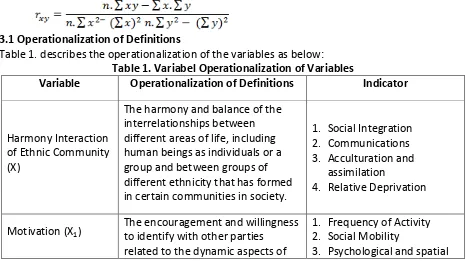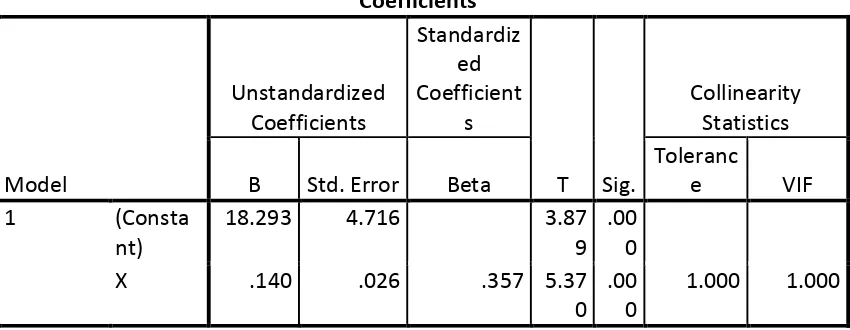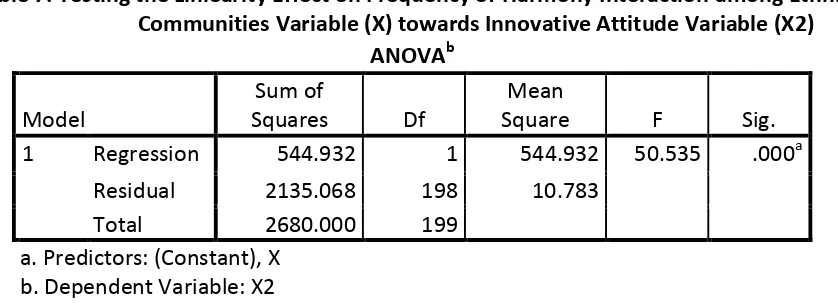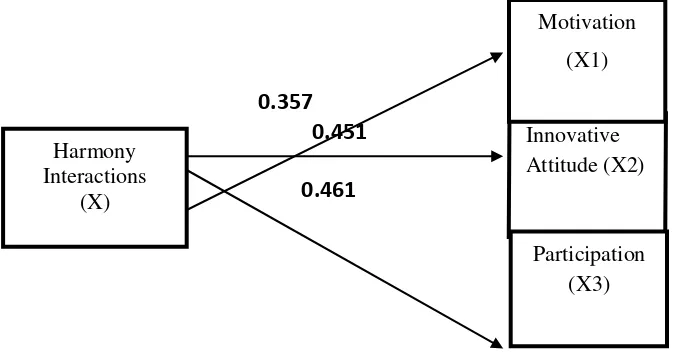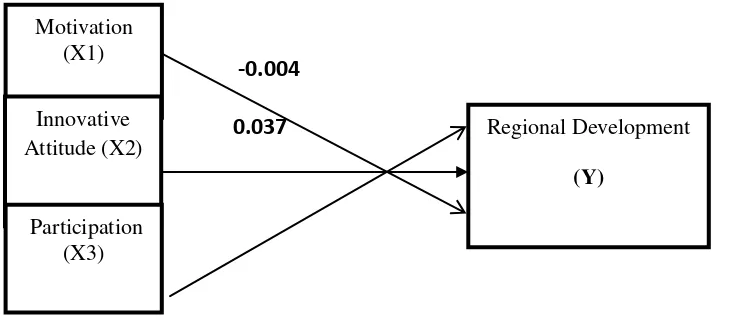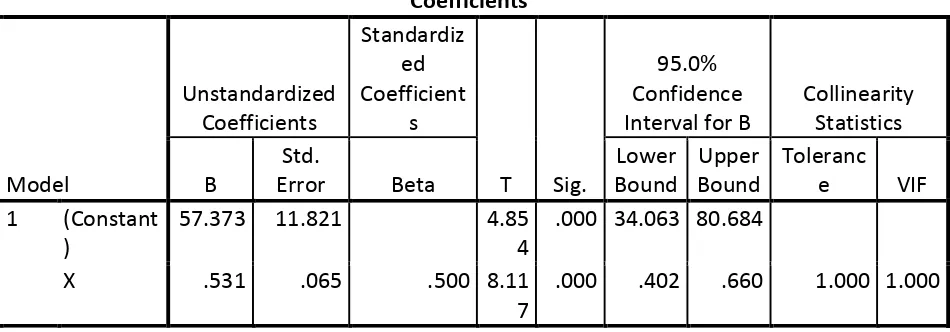International Journal of Academic Research in Business and Social Sciences December 2014, Vol. 4, No. 12 ISSN: 2222-6990
160
The Societal Participation On The Regional
Development
Sismudjito
University of North Sumatera
DOI: 10.6007/IJARBSS/v4-i12/1336 URL: http://dx.doi.org/10.6007/IJARBSS/v4-i12/1336
Abstract
The study aim to analyze the societal participation on the rural regional development. It consists of independent variable (harmonious interaction among ethnic communities) and the dependent variable (regional development) with several variables known as an intervening variable, namely; motivation, innovative attitude, and participation. The respondents of this study consist of communities in Secanggang sub-district. The data collection technique is using questionnaire, while the quantitative research techniques of cross-sectional methods is adopted. This study concluded that the participation of community members on the regional development is very high. This high participation of community members characterized by the collective consciousness shown by social solidarity and organization, mutual help and involvement.
Keywords: Motivation, Innovative Attitude, Participation, Regional Development
1.0 INTRODUCTION
Generally, people in this world both in the international and national scale, is always involved in the process of development. It includes the improvement of science and technology through formal and informal education, and increasing the socio-economic status through several activities in the allocation of natural resources. This kind of developments are able to improve the welfare, where the improvement of societal welfare is closely related to economic growth.
In the national scale, Indonesia as a country that consists of areas and pluralistic regions made up of various races, religions, races between groups. Those components are integrated into harmonious social units and characterized by a variety of socio-economic conditions spread across the entire community of Indonesia society. Some indicators of harmonious social units are the establishment of an interaction of several communities that create balance and unity. While, the socio-economic conditions found that there are communities lives under the poverty line.
International Journal of Academic Research in Business and Social Sciences December 2014, Vol. 4, No. 12 ISSN: 2222-6990
161 In relation to the various reports of the poor people, the Central Bureau of Statistics (in Ainindirianto, 2012) formulated the poverty indicators include:
1. Inability to meet basic consumption needs (food, clothing, shelter)
2. Lack of access to other basic needs (health, education, sanitation, clean water and transport)
3. The poor quality on human resources and limited on natural resources. 4. Vulnerability on the individual or mass shocks
5. Lack of appreciation in social activities
6. Lack of access to employment and sustainable livelihoods 7. Inability to strive for physically or mentally handicapped
8. Inability or social independence (abandoned children, women victims of domestic violence, marginalized groups)
According Setianingsih (2012), the problem of poverty is also related to non-fulfillment of basic rights of the poor to maintain and develop a life of dignity. If poverty can be described quantitatively by the numbers, it can be measured from the level of human resources. Overall attitude that causes a person to not be able to fully carry out his/her productive activities should be taken into account of poverty i.e. a combination of personality and environmental factors where individuals are interacting. Limitations of insight and lack of skills indicating low mastery of knowledge and technology. As a result, an individual or group will face a low ability to compete with other individuals and groups in society. In addition, poor health as a sign of poor nutrition which is caused by low incomes, work ethic as well as inadequate of natural resources.
Overall condition that spawns several problems is spreading to other regions in Indonesia, particularly in North Sumatra as a province that consists of 25 districts and 8 cities which has heterogeneous society. Along with its existence as a multi-ethnic society, the majority of the number of poverty is still relatively high. Soekarno (2006) stated that a heterogeneous society with diverse cultural backgrounds, races, and different ideologies conflict will easily occur that can lead to social upheavals. Such circumstances are driving the new changes starting with the fabric of interactions that foster increased participation of community members in the community concerned to achieve social harmony.
International Journal of Academic Research in Business and Social Sciences December 2014, Vol. 4, No. 12 ISSN: 2222-6990
162 2.0 LITERATURE REVIEW
2.1 Regional Development
The scope of the regional development is towards the regions that hava limitation in science and technology which is parallel to the socio-economic status or in other words, it indicated a low level of education and inadequate socio-economic conditions. The operational of regional development include poverty, inequality and unemployment through empowerment and sustainability. This kind of situations are happened in some developing countries. Frank (1984) asserted that developing countries do not have the mentality that is suitable for development. While Hagen in Frank (1984) added that people in developing countries have lack of creativity and willingness to take the initiative. This means that an attitude with low ability to control the future tend to solve problems by submitting to fate.
The living conditions of people in developing countries is still dominated by the local cultural confines. Some of them do not have the drive to succeed, or to achieve which aligned with the proposition of McClelland in Frank (1984) on need for achievement. A country may emphasized on the importance of human and cultural values, as well as providing capital and technology, then the achievement is gained. Basically, the need for achievement shaped the modern and cultural values that can generate the public encouragement for developing countries to excel or succeed in socio-economic development (Budiman, 2000). This will be incurred through the existance of interactions among community members in social life that evokes a comparative measure the norm of life.
2.2 Participation
Participation is a mental and emotional involvement of a person to achieve the objectives and take responsibility in it. According to Mikkelsen (1999) participation is an active process, which implies that the relevant person or group to take the initiative and use their freedom to do something. Furthermore Mikkelsen confirms participation known as a voluntary involvement by the public in a self-determined change. This means that participation is not passive, but actively demonstrated by the perpetrators, which been initiated to take part in community activities, outside of work or profession itself.
Soemanto (2005) posited that the public participation process incurred when residents as individuals and social groups or organizations are taking the role of the influence in the planning process, and monitoring of policies which directly affect their lives. They are consciously contributing voluntarily in development programs up to the evaluation stage. While, Conyers (1991) posited that the importance of community participation is a means to obtain information about the conditions, needs and attitudes of local people, who will see the presence of regional development projects. In the meantime, the public will be more trustful on development project or program if they are involved in the regional planning process. Along with this trust, it is a right of democracy when the people involved in the development of their own communities.
In relation to the participation of rural development, Adisasmita (2006) stated that the involvement of community members in all kinds of activities on the implementation of development planning is done by the local community. Based on the above definition, there are elements in the participation as follows:
International Journal of Academic Research in Business and Social Sciences December 2014, Vol. 4, No. 12 ISSN: 2222-6990
163 2. The willingness of the community to respond and be creative in the activities carried out.
From the description of the participation, there are elements that lead to engagement, response and creations. Engagement means participating in activities that take place; response is a reaction of action aimed at giving a response; creation is creativity that stems from the ideas.
According to Effendi (1992), there are two forms of participation; the vertical and horizontal. The vertical participation refers to a form of certain conditions in the community involved in it or take part in a program of other parties, in relation which the community is a subordinate position. Horizontally, where the people are not impossible to have initiative in which each member/community groups participate horizontally between each other, both in a joint effort, and in order to carry out activities with others. This kind of horizontal participation used as a sign of the societal growth that able to develop independently.
2.3 Social Organization
Basically, the social organization is a network of complex patterned behavior which exist in a broader scope of every society. According to Robin (1960) in Bertrand (1967), the social organization refers as human action considered in the mutual interdependence. In any interactions, the individuals hold the hopes if such interaction continues for a certain period, then the minimum degree will arise in the real patterns of behavior.
The community members are the members of social organizations due to the mutual relationship. The nature of the organization in modern society is structured, permeable or has conditional membership where it formed as political, profession, economic, NGOs, youth, hobbies and religion organization.
Moreover, the participation from outside the community arises from the existence of certain incentives in the form of materials or knowledge which they have benefited from these activities. As a result it can spur sustainable impulses. With the encouragement of self-participation related to the values , people will understand the urge to have attitudes that are embedded within every individual.
There are several factors that can influence people's participation in a program. Some are able to support or hinder the program. This includes; age, gender, limited possessions, education, length of stay, employment and income (Angell in Ross, 1967).
2.4 Social Solidarity
According to Johnson (1981), the social solidarity is a concern shared by the group that shows a state of relationship between individuals or groups based on the moral equation, collectiveness and beliefs which reinforced by the emotional experience. The existence of social solidarity has a variety of forms, including; (a) the exchange of land with labor; (b) the assistance of workforce to help the Head of a village; (c) working together without being paid; and (d) provide assistance or gifts, exchange of goods with the goods.
International Journal of Academic Research in Business and Social Sciences December 2014, Vol. 4, No. 12 ISSN: 2222-6990
164 social solidarity includes; sympathetic and need for each other. While, Johnson (1981) added that the mechanical solidarity based on a shared collective consciousness shows the totality of beliefs and sentiments.
The complexity of the concepts that have been described earlier that the relationship between motivation, innovative and participatory attitude have a positive relationship. Its mean that when the motivation of the community both local and religious values, education and understanding of the pluralism values would be an adverse impact on the growth of innovative attitude (ideas, inventions, alternative) in the community. When the motivation is going forward for many people, so innovative attitude will be reflected in the high levels of participation (hard work, diligent, thrifty, unyielding) for the betterment of the community.
One form of participation is the mutual assistance. In general, mutual cooperation refers to activities to help each other in society. Furthermore, this bond to be a mechanical solidarity that is characteristic of rural communities (Durkheim in Soenarto, 2004) which been structurally integrated undertaken by limited social exchange. This is due to the homogeneous in the mentality and morality as well as having both a collective consciousness and faith. Through mutual support of institutions, the changes in community structure, a healthier social management and better human resources competencies can be built up as well as socio-political leadership both in the local community and national levels. The collective movement in institutional is strengthening the mutual assistance that will make it easier for self-reliance of a nation based on social justice.
2.5 Conceptual Framework
International Journal of Academic Research in Business and Social Sciences
December 2014, Vol. 4, No. 12 ISSN: 2222-6990
165 Figure 1. Conceptual Framework
MOTIVATION (X1)
INNOVATIVE
ATTITUDE(X2)
PARTICIPATION (X3)
REGIONAL
DEVELOPMENT(Y)
HARMONY INTERACTION AMONG ETHNIC
COMMUNITY (X)
Improvement on infrastructure Natural Resources.
Human Resources
Improvement on Socio-Economic Aspirational
Accessibility
Community Empowerment
The level of abstraction
Social Solidarity Communication
Psychological and spatial
Participation Social Organization
Acculturation & Assimilation
Relative Deprivation Social Integrity
Social Mobility Frequency of
International Journal of Academic Research in Business and Social Sciences December 2014, Vol. 4, No. 12 ISSN: 2222-6990
166 www.hrmars.com
2.6 Hypothesis
1. The harmony interactions among ethnic community (X) has a positive influence to the motivation of the community members (X1)
2. The harmony interactions among ethnic community (X) has a positive influence to innovative attitude of community members (X2)
3. The harmony interactions among ethnic community (X) has a positive influence to the participation of community members (X3)
4. The motivation of the community members (X1) has a positive effect on the regional development (Y)
5. The innovative attitude of community members (X2) has a positive effect on regional development (Y)
6. The participation of community members (X3) has a positive effect on the regional development (Y)
3.0 METHODOLOGY
The study uses a quantitative approach. The questionnaire was developed and distributed to 13 (thirteen) villages of Secanggang sub-district in Langkat district as the population of this study. The quantitative technique is to look for relationship between variables and prove the positive influence of independent variables on the intervening variables and dependent variable using statistical measures in hypothesis testing. The measures used include; product moment correlation to see the coefficient of correlation between the variables (Sinulingga, 2011). The correlation between the variable of harmony interactions among ethnic communities with variables of motivation, innovative attitude, participation and regional development. Below is the given formula:
3.1 Operationalization of Definitions
Table 1. describes the operationalization of the variables as below: Table 1. Variabel Operationalization of Variables
Variable Operationalization of Definitions Indicator
Harmony Interaction of Ethnic Community (X)
The harmony and balance of the interrelationships between different areas of life, including human beings as individuals or a group and between groups of different ethnicity that has formed in certain communities in society.
1. Social Integration 2. Communications 3. Acculturation and
assimilation
4. Relative Deprivation
Motivation (X1)
The encouragement and willingness to identify with other parties
related to the dynamic aspects of
1. Frequency of Activity 2. Social Mobility
International Journal of Academic Research in Business and Social Sciences
The degrees on reciprocal speed of new innovations.
1. The level of abstraction 2. Accessibility
Table 2. The Measure on Positive Effect of Harmony Interaction among Ethnic Community Variable (X) on Motivation Variable (X1)
Coefficientsa
International Journal of Academic Research in Business and Social Sciences December 2014, Vol. 4, No. 12 ISSN: 2222-6990
168 www.hrmars.com
communities (X) to the motivation of community members (X1) have similar direction. The more harmonious in society, the higher the motivation.
Meanwhile, to determine the significancy of both variables, it can be seen from probability numbers (sig) of 0.00 is less than 0.05. If the probability number > 0.05, then the two variables have no significant effect. The analysis of this measure will be analyzed in Table 3 below:
Table 3. The Frequency Analysis of Harmony Interactions among Ethnic Community Variable (X) on the Motivation Variable (X1)
Model Summaryb
Mod
el R
R Squar
e
Adjusted R Square
Std. Error of the Estimate
Change Statistics Durbin -Watso
n R
Square Change
F
Change df1 df2
Sig. F Chang
e
1 .35
7a
.127 .123 4.80595 .127 28.841 1 198 .000 1.693
As illustrated in the above Table, the R Square as the coefficient determinant is 0.127 or 12.7%. This means that there is a significant positive effect of the harmony interaction among ethnic communities (X) on the motivation of community members (X1). Both have similar direction, thus the harmonious interaction of a community, the higher the level of motivation. There are several indicators which embody the harmony of interaction between communities, among others; the frequency of contact directly or indirectly, the intensity of communication, a high degree of unity among the community that exists through the sense of belonging which consequently boost motivation levels.
International Journal of Academic Research in Business and Social Sciences December 2014, Vol. 4, No. 12 ISSN: 2222-6990
169 www.hrmars.com
Table 4. Testing the Liniearity Effect on Frequency of Harmony Interaction among Ethnic Communities Variable (X) towards Motivation Variable (X1)
ANOVAb
Model
Sum of
Squares Df
Mean
Square F Sig.
1 Regression 666.152 1 666.152 28.841 .000a
Residual 4573.243 198 23.097
Total 5239.395 199
a. Predictors: (Constant), X b. Dependent Variable: X1
Based on the above results, the significant value is 0.000 (<0.05). Thus Ho is rejected and H1 is accepted, means that there is a linear effect of the frequency of harmony interaction among ethnic communities variable (X) on the motivation variable (X1) of the community members.
B. The Positive Effect of Harmony Interaction among Ethnic Community Variable (X) on Innovative Attitude Variable (X2)
Table 5. The Measure on Positive Effect of Harmony Interaction among Ethnic Community Variable (X) on Innovative Attitude Variable (X2)
Coefficientsa
Model
Unstandardized Coefficients
Standardize d Coefficients
t Sig.
Collinearity Statistics
B
Std.
Error Beta
Toleran ce VIF
1 (Constant) 10.352 3.222 3.212 .002
X .127 .018 .451 7.109 .000 1.000 1.000
a. Dependent Variable: X2
International Journal of Academic Research in Business and Social Sciences December 2014, Vol. 4, No. 12 ISSN: 2222-6990
170 www.hrmars.com
To see whether the frequency variable of harmony interaction among ethnic communities (X) affects the innovative attitude variable (X2) of community members or otherwise, thus the analysis shown below:
Table 6. The Frequency Analysis of Harmony Interactions among Ethnic Community Variable (X) on Innovative Attitude Variable (X2)
Model Summaryb
As illustrated in the above Table, the R Square as the coefficient determinant is 0.203 or 20.3%. This means that there is a significant positive effect of the harmony interaction among ethnic communities (X) on the innovative attitude of community members (X1). Meanwhile, the regression model used to see the liniearity effect on frequency of harmony interactions among ethnic communities variable (X) on the innovative attitude variable (X1) of community members as in below Table:
Table 7. Testing the Liniearity Effect on Frequency of Harmony Interaction among Ethnic Communities Variable (X) towards Innovative Attitude Variable (X2)
ANOVAb
International Journal of Academic Research in Business and Social Sciences December 2014, Vol. 4, No. 12 ISSN: 2222-6990
171 www.hrmars.com
C. The Positive Effect of Harmony Interaction among Ethnic Community Variable (X) and Participation Variable (X3)
Table 8. The Measure on Positive Effect of Harmony Interaction among Ethnic Community Variable (X) and Participation Variable (X3)
Coefficientsa
Model
Unstandardized Coefficients
Standardiz ed Coefficient
s
T Sig.
Collinearity Statistics
B
Std.
Error Beta
Toleranc
e VIF
1 (Constan t)
17.877 3.524 5.073 .000
X .143 .019 .461 7.318 .000 1.000 1.000
a. Dependent Variable: X3
As depicted in the above Table, the numbers of positive influence on the frequency of harmony interaction among ethnic communities (X) to participation of community members is 0.461, means that the influence of these two variables is high. The effect between these two variables shows that the influence on the frequency of harmonious interaction among ethnic communities (X) to the participation of community members (X3) have the same direction. The more harmonious in society, the higher the participation. To address whether the harmony interaction among ethnic communities (X) affect the participation members of the community (X3), the analysis of both relationship is explained in the below Table:
Table 9. The Frequency Analysis of Harmony Interactions among Ethnic Community Variable (X) on Participation Variable (X3)
Model Summaryb
Model R R Square
Adjusted R Square
Std. Error of the Estimate
Durbin-Watson
1 .461a .213 .209 3.59104 1.551
a. Predictors: (Constant), X b. Dependent Variable: X3
International Journal of Academic Research in Business and Social Sciences December 2014, Vol. 4, No. 12 ISSN: 2222-6990
172 www.hrmars.com
communities variable (X) on the participation variable (X3) of community members as in below Table:
Table 10. Testing the Liniearity Effect on Frequency of Harmony Interaction among Ethnic Communities Variable (X) towards Participation Variable (X3)
ANOVAb
Model
Sum of
Squares Df
Mean
Square F Sig.
1 Regression 690.678 1 690.678 53.559 .000a
Residual 2553.322 198 12.896
Total 3244.000 199
a. Predictors: (Constant), X b. Dependent Variable: X3
Based on the above results, the significant value is 0.000 (<0.05). Thus Ho is rejected and H1 is accepted, means that there is a linear effect of the frequency of harmony interaction among ethnic communities variable (X) on the participation variable (X3) of the community members. Thus, symbolically the positive influence of harmony interaction among ethnic communities variable (X) on the motivation variable (X1); innovative attitude variable (X2); participation variable (X3) of the community members shown as in the chart plot of Figure 2 below:
0.357
0.451
0.461
Figure 2. The positive influence of harmony interaction among ethnic communities variable (X) on the motivation variable (X1); innovative attitude variable (X2); participation variable
(X3).
Overall the calculated results which have various values are presented in the diagram of the effect of harmony interaction among ethnic communities variable (X) on the intervening variable of motivation (X1); innovative attitude variable (X2) and the participation variable (X3). This indicates the level of influence on the independent variable and intervening variables.
Harmony Interactions
(X)
Innovative Attitude (X2)
Motivation
(X1)
International Journal of Academic Research in Business and Social Sciences December 2014, Vol. 4, No. 12 ISSN: 2222-6990
173 www.hrmars.com
D.The Results of Data Processing: The Positive Influence of Motivation Variable (X1); Innovative Attitude Variable (X2); Participation Variable (X3) on the Regional Development variable (Y)
The results on the effect of the three intervening variables (motivation, innovative attitude and participation) on the dependent variable (regional development) illustrate that the two variables (innovative motivation and attitude) are not significant to the variable of regional development. Both variables negatively affect the regional development. However, the intervening variable of participation has a significant influence. The results of positive and negative effects of the three variables can be seen in Table 11 as follows:
Table 11. The Results of Negative and Positive Effects on the Three Variables
Coefficientsa
Model
Unstandardized Coefficients
Standardize d Coefficients
T Sig.
Collinearity Statistics
B Std. Error Beta Tolerance VIF
1 (Consta nt)
78.65 0
10.915 7.206 .000
X1 -.010 .180 -.004 -.056 .956 .872 1.146
X2 .142 .287 .037 .493 .623 .672 1.487
X3 1.609 .253 .468 6.363 .000 .717 1.395
a. Dependent Variable: Y
The negative influence of motivational (X1) and innovative attitude variables (X2) and the positive impact of participation variable (X3) of community members on the regional development variable (Y) can be seen in the chart plot of Figure 3 below:
-0.004
0.037
0.468
Figure 3. Negative Effects of Motivation Variable (X1), Innovative Attitude Variable (X2) on Motivation
(X1)
Innovative Attitude (X2)
Participation (X3)
Regional Development
International Journal of Academic Research in Business and Social Sciences December 2014, Vol. 4, No. 12 ISSN: 2222-6990
174 www.hrmars.com
The Regional Development Variable (Y) and the Positive Effect of Participation Variable (X3) on The Regional Development Variable (Y)
E. The Results of Data Processing: The positive influence of Harmony Interactions among Ethnic Communities Variable (X) on the Regional Development Variable (Y)
The major hypothesis testing is the harmony interaction among ethnic communities variable (X) through the operation of motivational variable (X1), innovative attitude variable (X2), participation variable (X3) of community members influence a positive effect on the regional development (Y). The calculation process stated in Table 12 below:
Table 12. The Calculation Process of Major Hypothesis Testing of Harmony Interaction among Ethnic Community variable (X) through the operation of Motivation variable (X1), Innovative
Attitude variable (X2), Participation variable (X3) on The Regional Development (Y)
Coefficientsa variable (X1); innovative attitude variable (X2); participation variable (X3) of community members and the harmony interaction among ethnic communities (X) has a positive effect on the regional development variable (Y) significantly with a coefficient of 0.500. Based on t test, the significant values is smaller than the 0.00 of tolerance value of 0.05, means that the hypothesis can be accepted. There was a linear effect between variables of harmony interaction among ethnic communities (X) on the construction of the regional development variable (Y)
International Journal of Academic Research in Business and Social Sciences December 2014, Vol. 4, No. 12 ISSN: 2222-6990
175 www.hrmars.com
Through the calculation of path analysis, the operationalization of variables can be determined which has contribution to this research.
This study consists of independent variable (harmonious interaction among ethnic communities) and the dependent variable (regional development). In the meantime, there are several variables known as an intervening variable, namely; motivation variable (X1), innovative attitude (X2) participation (X3) which serves as a liaison from the independent variable to the dependent variable. Through the operation of these three variables, thus the regional development variable (Y) can be realized.
Basically the path coefficient of multiple linear regression coefficients have been standardized was used to determine the effect (not prediction) of endogenous to exogenous variables (Riduwan and Engkos Achmad Kuncoro, 2007). In connection with some of the variables that are formulated in this study, which was placed in the exogenous variable is harmonious interaction among ethnic communities (X) and the endogenous variable is the regional development (Y). In the meantime, in addition to exogenous and endogenous variables, there are intervening variables that motivation (X1), innovative attitude (X2) and the participation (X3) that serves as a liaison between the exogenous and endogenous variables. Therefore, multiple regression analysis using path analysis techniques can be plotted as depicted in the below Figure:
0.357 -0.004
<<
0.451 0.037
0.461 0.468
5.0 CONCLUSION AND RECOMMENDATION
The participation of community members in the Secanggang subdistrict on the regional development is very high. This high participation of community members characterized by the collective consciousness shown by social solidarity and organization, mutual help and involvement. The collective consciousness is not limited in the scope of a particular activity, but also covers all aspects of the ideological, political, economic, social, cultural and security in all levels of society.
Harmony Interactions among Ethnic Communities
(X)
Regional Development
(Y) Motivation
(X1)
Innovative Attitude (X2)
International Journal of Academic Research in Business and Social Sciences December 2014, Vol. 4, No. 12 ISSN: 2222-6990
176 www.hrmars.com
Through the conclusions mentioned above, this study suggests that the community potential is so harmonious when faced with a development pioneered by the government and now, how to optimize public participation in the development implementation to be achieveable. The regional development should be conducted with the involvement of local potential concists of community participation in the development or better known as participatory planning and community development through a bottom up planning system.
Reference
Ainindirianto. (2012). Kemiskinan dan Solusinya. Jakarta: Universitas Gunadarma Adisasmita, R. (2006). Membangun Desa Partisipatif. Yogyakarta: Graha Ilmu
Bertrand, Alvin L. (1980). Sosiologi. Kerangka Acuan, Metode Penelitian, Teori-teori Tentang
Sosialisasi, Kepribadian dan Kebudayaan. Surabaya: Penerbit PT. Bina Ilmu
Badan Pusat Statistik BPS. (2011). Angka Kemiskinan Di Indonesia
Budiman, A. (2000). Teori Pembangunan Dunia Ketiga. Jakarta: PT. Gramedia, Pustaka Utama. Conyers, D. (1991). Perencanaan Sosial di Dunia Ketiga: Suatu Pengantar. Ed 2. (Penerjemah:
Susetiawan). Yogyakarta: Gajah Mada University Press
Effendy, O. U. (1992). Dinamika Komunikasi. Bandung: Remaja Rosdakarya
Johnson, D. P. (1994). Sociological Theory: Classic and Modern, terj. Robert M. Z. Lawang "Teori Sosiologi Klasik dan Modern". Jakarta: PT Gramedia Pustaka Utama, Jilid I.
Laiya, B. (1983). Solidaritas Keluarga Dalam Salah Satu Masyarakat Desa Nias Indonesia. Yogyakarta : Gadjah Mada University Press.
Mahalli, K. (2010) Pembangunan Perdesaan, Teori dan Praktek. Medan: USU Press
Mikkelsen, B. (1999). Metode Penelitian Partisipatoris Dan Upaya-Upaya Pemberdayaan:
Sebuah Buku Pegangan Bagi Para Praktisi Lapangan. Jakarta: Yayasan Obor Indonesia.
Ross, Murray G., and B.W. Lappin. (1967). Community Organization: Theory, Principles and
Practice. Second Edition. New-York: Harper & Row Publishers.
Sihombing, Marlon. (2007). Desentralisasi dan Pembangunan Masyarakat Wilayah Pesisir
Kabupatet Langkat. Propinsi Sumatera Utara. Program Studi Perencanaan Wilayah
Sekolah Pasca Sarjana, Universitas Sumatera Utara,. Disertasi Tidak Diterbitkan Soekanto, S. (2006). Sosiologi Suatu Pengantar. Jakarta: P.T Raja Grafindo Persada.
Soemanto, H. (2003). Inovasi, Partisipasi dan Good Governance: 20 Prakarsa Inovatif Dan Partisipatif di Indonesia. Jakarta: Yayasan Obor Indonesia

